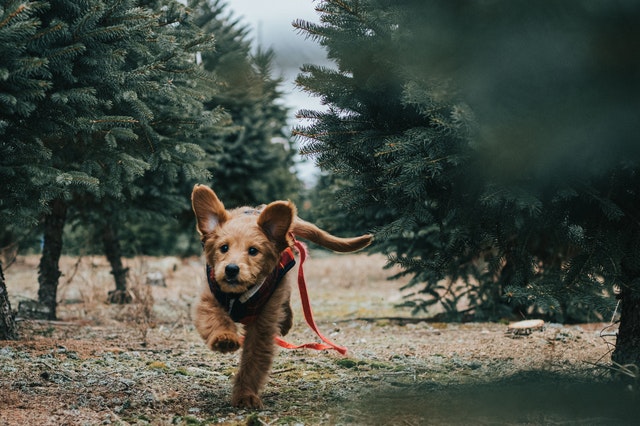
How to Pick Up a Small Dog
If you need to pick up a small dog you can do this easily by placing one of your hands under the rear legs and the other hand on the chest. If you will be picking up a puppy you can do that by placing one of your hands or both of them under the puppy’s chest and bringing the puppy to your chest in a smooth motion. Don’t forget to support your puppy in a cradle with both of your hands. If your dog does not like being picked up you can place one of your hands under their chest and you can use the other to grab onto their scruff so the dog can’t easily turn around and bite you.
How to Pick Up a Medium-Sized Dog
As long as your dog is calm you can pick him/her up by placing one of your hands under the rear legs and the other hand under the chest. Alternatively, you can put one of your hands under the lower part of their chest just before the belly and the other hand under the upper part of their chest just before their front legs. That is called a “chest cradle” but keep in mind that this should not be used with larger breeds.
How to Pick Up a Large Dog
If your big paw friend is not feeling too well and has trouble getting in your vehicle or you need them moved into your bath for a shampoo appointment you might need help. Don’t be shy to ask for help as your big buddy might be too much for you to handle. Take care not to pick up your big dog by placing your hand on its belly. Place one of your hands beneath their back legs and the other one should be positioned under their chest or the lower part of their neck. If you are doing this with a partner tell them to put their hands under the dog's chest and grab them firmly. If you are on the back end, do not grab your dog from the back but stand on their left or right side and then place your hands under their hind legs.
If your dog is not too heavy and you are able to pick him up on your own, support his hind legs with one arm, and with the other arm support your dog underneath his chest or neck. If he is anxious then you can hold his scruff to prevent him from biting you, or attach a muzzle and a short lead so that you can control his head more effectively.
How to Pick Up a Pregnant Dog
Most veterinarians advise against picking up a pregnant dog as this may expose the dog to health problems. As you may expect, it is best to avoid applying pressure on the dog’s belly as much as possible if you need to lift her up. There is a correct way of doing this and it is very easy — place one of your hands as firm support beneath the hind legs of the dog and the other hand as support under the front legs and the chest.
How to Pick Up a Dog with Back Problems
Intervertebral Disc Disease (IVDD) is the most common cause of back pain in dogs and is mostly encountered in breeds like the Dachshund, the Pekinese, the Beagle, and the Lhasa Apso as explained here. The condition is caused by damage to the vertebrae and depending on the severity can have different implications. The symptoms include a "drunken sailor" type of walk (the legs cross when the dog is walking and there is a wobble in their stride), lack of motivation to walk around the room, a pain in the back, loss of walking or inability to move the legs voluntarily. Osteoarthritis is another common problem for older and/or obese dogs that plagues about a quarter of the dog population worldwide. It is a chronic joint disease characterized by loss of joint cartilage and new bone formation around the joint which is accompanied by pain and potential limb dysfunction. You can read more about this here.
It is not recommended to pick up a dog with back problems unless this is absolutely needed, please talk to your veterinarian for the best treatment. You can properly pick up a dog with back problems by placing one of your arms between the dog’s front legs and the other one between the dog’s hind legs. It is imperative to make sure you are supporting the dog’s weight evenly across the entire length of its body. If your dog is in pain or anxious you might need to put a muzzle on them before picking them up, he/she may bite you, so be cautious.
How to Pick Up a Dog with Dysplasia
Dysplasia, otherwise knowns as Canine Hip Dysplasia (CHD), is a health condition that begins in dogs as they grow and results in instability or a loose fit of the hip joint as described by the American College of Veterinary Surgeons. There are many causes for this health condition but most veterinarians agree that genetics play the main part. I should add that some breeds have special nutritional needs to avoid developing canine hip dysplasia so you should talk to your veterinarian about this. Bigger breeds like Great Dane, German Shepherds, Golden Retrievers, Newfoundlands, Mastiffs, and Rottweilers. The symptoms of this health condition include limping, reluctance to stand up, shifting weight to the forward limbs, hip pain, and loss of muscle mass on the rear limbs.
If your dog is suffering from canine hip dysplasia it might need a lot of carrying around. Some dogs may need a little help getting up from their bed and a lot of help when going in and leaving your vehicle. It is recommended to avoid putting as much pressure on the hind legs as possible so your dog is not in pain. Use one arm to support your dog’s rear under his/her stomach and use your other arm to support his/her chest. As mentioned above, if your dog is in pain you might need to put a muzzle on them before picking them up, he/she may bite you as a defensive reaction.












